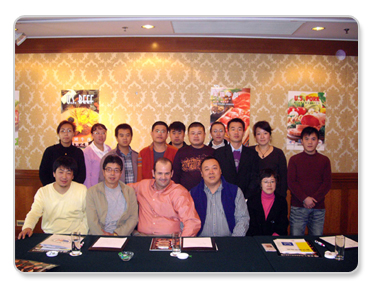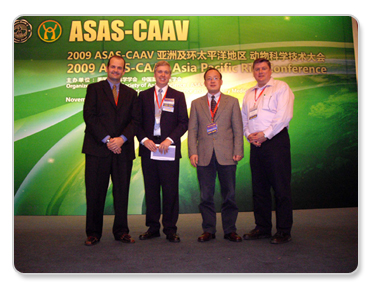OSU Animal Scientist Talks U.S. Beef in China
Tuesday, December 22, 2009

China’s appetite for beef is growing at a long-term trend rate that is unparalleled
by any other major consuming market. That is one reason that Oklahoma State University’s
Dr. Brad Morgan, department of animal science meat scientist, recently traveled to
all-corners of China and talked to several purchasing groups regarding the usefulness,
high quality and safety associated with the current U.S. beef offering.
“China’s foodservice and restaurant sectors have expanded at a rate double than that
of its already torrid GDP growth,” Morgan said. “One can find a plethora of new beef-focused
restaurants, ranging from hot pot and Korean barbecue restaurants to the golden arches
of McDonalds in primary cities like Beijing and Shanghai, which have 18 million people
each, as well as smaller secondary cities as well.”
However, Morgan said China’s beef industry faces structural problems meeting the new
demand. Household cow-calf operations and the small, but growing, feedlot industry
remains in the hands of small households, whom in recent years have chosen to raise
hogs and poultry rather than beef cattle. Cattle’s long production cycle and lean
profits make investment unattractive.
“China’s ‘modern’ beef slaughter and processing industry, the majority of whose infrastructure
is less than 10 years old, is squeezed between high cattle prices and demand constraints
for most beef products,” Morgan said.
While in China, Morgan, with the cooperation of the U.S. Meat Export Federation, conducted
a series of one-day workshops with several of the largest Chinese food importing and
processing businesses that are beginning to utilize U.S. beef items into their operations.
One of the organizations was the COFCO Corporation, which is China’s largest diversified
products and services supplier in agribusiness and food industry.
Morgan said this company is similar to Cargill or ConAgra in the U.S. in that they
are not only in the meat processing business, but they are also leaders in the wine,
hotel, snack food and canned food items manufacturing.
During the seminars, Morgan discussed the overview of the U.S. beef industry, the
process associated with beef carcass grading, and the ongoing and future aspects associated
with beef safety programs.
“I was amazed by their level of questions and their thirst for knowledge regarding
the various aspects associated with the U.S. beef industry,” Morgan said.
In addition to these lectures, Morgan was one of two U.S. scientists asked to speak
to 800 attendees from 18 countries during the inaugural Pacific Rim Conference, organized
by the American Society of Animal Science and the Chinese Association of Animal Science
and Veterinary Medicine.
Morgan, who has conducted research or been a featured speaker in 30 different countries,
said the conference was a first-time venture into international venues in hopes to
bridge gaps and facilitate communication and information sharing between these existing
memberships and this growing community of animal and meat scientists in China.
“Currently, the 1.3 billion Chinese are consuming 6 million tons of beef annually,
of which they are only raising approximately 25 percent of their demand,” Morgan said.
“We need them to understand U.S. beef and everything that is literally brings to their
tables.”

